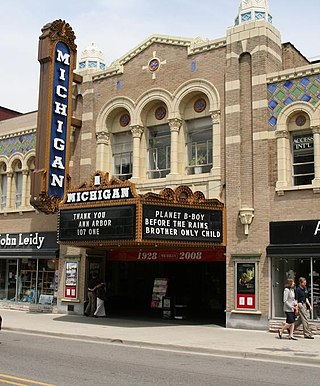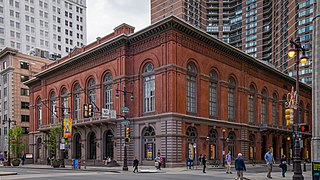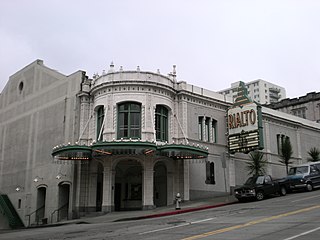
The Fox Theatre is a performing arts center located at 2211 Woodward Avenue in Downtown Detroit, Michigan, near the Grand Circus Park Historic District. Opened in 1928 as a flagship movie palace in the Fox Theatres chain, it was at over 5,000 seats the largest theater in the city. Designed by theater architect C. Howard Crane, it was listed on the National Register of Historic Places in 1985.

The Michigan Theater is a movie palace in Ann Arbor, Michigan, United States, right adjacent to the Central Campus of the University of Michigan. It shows independent films and stage productions, and hosts musical concerts.

The Academy of Music, also known as American Academy of Music, is a concert hall and opera house located at 240 S. Broad Street in Philadelphia, Pennsylvania. Its location is between Locust and Manning Streets in the Avenue of the Arts area of Center City.

The Arlington Theatre is a historic movie theatre in Santa Barbara, California, United States. Combining the Mission Revival and Spanish Colonial Revival styles of architecture, it the largest movie theater and principal performing arts venue the city. In addition to regular screenings and artists, it is home to many events associated with the annual Santa Barbara International Film Festival.

The Music Hall, in Tarrytown, New York, United States, is located on West Main Street downtown. It is a brick structure in the Queen Anne architectural style erected in the late 19th century. In 1980, it was listed on the National Register of Historic Places.

The Somerville Theatre is an independent movie theater and concert venue in the Davis Square neighborhood of Somerville, Massachusetts, United States. Over one hundred years old, the Somerville Theatre started off as a vaudeville house and movie theater. The theater has since transitioned and now operates as a live music venue and first-run movie theater. As a music venue, the theater has played host to many historic concerts, including the first of the two Last Dispatch concerts, two shows by Bruce Springsteen in 2003, and a performance by U2 in 2009. Recent live performances have included Ryan Adams & the Cardinals, Cursive, Norah Jones, The Jonas Brothers, Joan Baez, and the John Butler Trio.

An atmospheric theatre is a type of movie palace design which was popular in the late 1920s. Atmospheric theatres were designed and decorated to evoke the feeling of a particular time and place for patrons, through the use of projectors, architectural elements and ornamentation that evoked a sense of being outdoors. This was intended to make the patron a more active participant in the setting.

The Palace Theatre is an entertainment venue in downtown Albany, New York, located on the corner of Clinton Avenue and North Pearl Street. The theatre is operated by the Palace Performing Arts Center, Inc - a 501(c)(3) non-profit organization. Established in 1984 and incorporated as a not-for-profit corporation in 1989, the Palace Performing Arts Center, Inc. was created to operate the theatre and utilize its full potential as a cultural and entertainment center in Albany.

The Rialto Theatre in Tacoma, Washington was built in 1918 to showcase movies. Its design reflects the affluence following World War I. It reflects the character of a palace and is the result of efforts by entrepreneur Henry T. Moore and Tacoma architect Roland E. Borhek. Designed to hold 1500 patrons and retail space. The two-and-a-half-story structure is in the historic downtown of Tacoma. The area has long been associated with theaters and entertainment. The theater is freestanding, with a dramatic view on an incline with a classical façade sheathed of glazed white terra cotta. Both the interior and exterior retain most of the original design of Roland E. Borhek. The theater has an auditorium, proscenium with stage, a relocated projection booth, balcony, lobby, and commercial space. It has been altered with the removal of the storefronts and marquee. On the inside, the lobby's decorative ceiling has been hidden and the concession areas expanded.

The Ulster Performing Arts Center (UPAC), originally the Broadway Theater and Community Theatre, is located on Broadway in Kingston, New York, United States. A Classical Revival building built in 1926, it is the only unaltered pre-World War II theater left in the city, and one of only three from that era in the Hudson Valley. It is also the largest proscenium theater between Manhattan and Albany.

The Orpheum Theatre is a historic theater in downtown Wichita, Kansas, United States. It was designed by renowned theatre architect John Eberson with funding from a group of local investors and opened on September 4, 1922.

The Standard Theatre, now known as the Folly Theater and also known as the Century Theater and Shubert's Missouri, is a former vaudeville hall in downtown Kansas City, Missouri. Built in 1900, it was designed by Kansas City architect Louis S. Curtiss. The theater was associated with the adjoining Edward Hotel, which was also designed by Curtiss; the hotel was demolished in 1965.

The Majestic Theatre is a performing arts theater in the City Center District of Downtown Dallas. It is the last remnant of Theater Row, the city's historic entertainment center on Elm Street, and is a contributing property in the Harwood Street Historic District. The structure is a Dallas Landmark and is listed on the National Register of Historic Places.

The Mississippi Lofts and Adler Theatre is an apartment building and theater complex located in downtown Davenport, Iowa, United States. It is individually listed on the National Register of Historic Places by its original name, the Hotel Mississippi and RKO Orpheum Theater. The Hotel Mississippi was listed on the Davenport Register of Historic Properties in 2005. In 2020 the complex was included as a contributing property in the Davenport Downtown Commercial Historic District.

The RKO Keith's Theater was an RKO Pictures movie theater at 129-43 Northern Boulevard in the Flushing neighborhood of Queens in New York City. It was designed by architect Thomas W. Lamb and built in 1928. While the RKO Keith's had a plain three-story facade, its interior was elaborately designed in a Spanish Baroque Revival style. The theater had a square ticket lobby and an oval grand foyer, which led to the double-level auditorium. The auditorium was designed as an atmospheric theater with a blue ceiling and gilded-plaster decorations; it contained 2,974 seats across two levels. There were also four lounges and a mezzanine promenade.

The Cascade Theatre is a prominent example of the Art Deco style in Redding, California. The cinema was designed by J. Lloyd Conrich of San Francisco in 1934 for the Naify family, who operated the Golden State Theaters chain of movie theaters in northern California, which later became the United Artists Theaters. The new cinema was built in 1935 by Salih Brothers and opened on August 9 with 1348 seats. It was the first air conditioned public building in Redding. In 1979 the large house was subdivided into four smaller theaters, and in 1997 it closed. The Cascade Theatre reopened in 2004 after it was purchased by Southern Oregon University and the JPR Foundation. The house was restored to its original configuration and it is used as a community auditorium and arts center.

The Martha Ellen Auditorium, now the State Theatre, was built 1916 in Central City, the county seat of Merrick County in the state of Nebraska in the midwestern United States. It is listed in the National Register of Historic Places, as a well-preserved example of a Nebraska opera house.

The Marion Palace Theatre is a movie palace constructed in 1928 in Marion, Ohio, United States for the Young Amusement Company. The original cost of the project was $500,000. It is listed on the National Register of Historic Places because of its significance to the atmospheric theatre architectural style popular in the United States during the 1920s.

The Stavros Niarchos Foundation Parkway, or simply the Parkway, is a movie theater located at 5 West North Avenue in Baltimore, Maryland. The Parkway is open as of May 3, 2017, and is the new permanent home of MdFF. The Maryland Film Festival, a 5-day annual festival created and operated by MdFF, is housed in and around the Parkway and throughout the Station North Arts and Entertainment District.

The Lauren K. Woods Theatre is located on the campus of Monmouth University, at 370 Cedar Ave, in Long Branch, New Jersey.





















